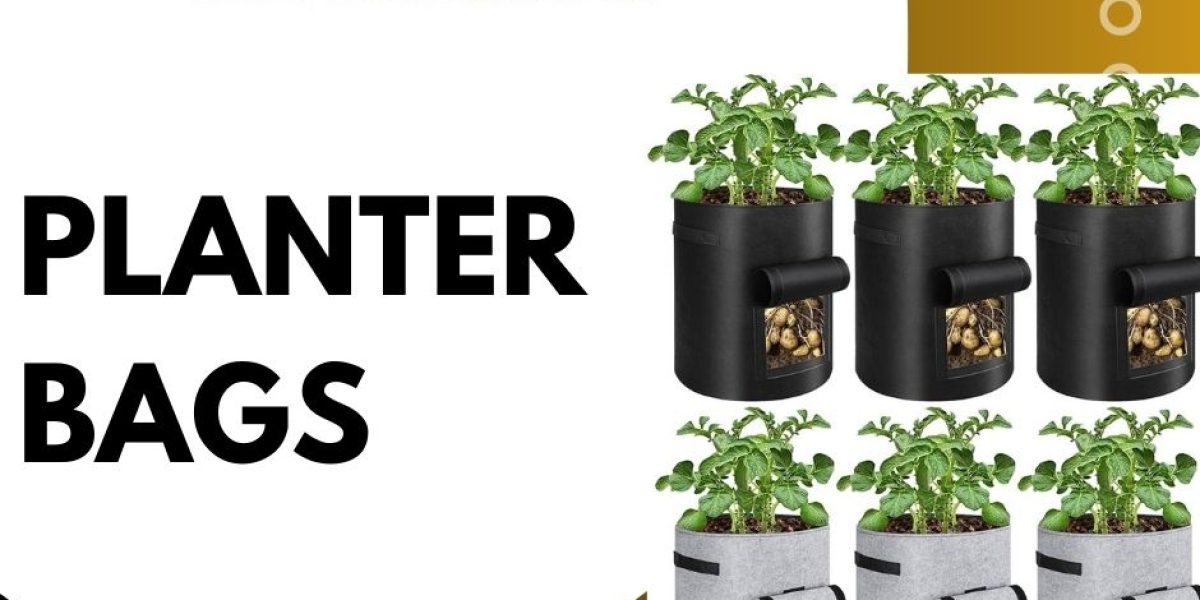When it comes to gardening, one of the first decisions a gardener faces is what type of container to use for their plants. The debate between planter bags and traditional pots has gained significant attention, particularly as more people embrace container gardening and urban farming. Both options have their pros and cons, depending on your gardening needs, available space, and the type of plants you want to grow. In this article, we will compare planting garden bags and traditional pots, exploring their features, benefits, and drawbacks to help you make an informed decision about which option is best for you.
What Are Planter Bags?
Planting garden bags are flexible, breathable fabric containers designed to hold soil and support plant growth. These bags are usually made from a high-quality fabric that is breathable, UV-resistant, and durable. The fabric allows air to circulate around the plant’s roots, promoting healthy growth and preventing the issues that often arise from root-bound plants in traditional pots. Garden bags for planting come in various sizes and shapes, allowing for a wide range of gardening applications, from small herbs to larger vegetable gardens and flowers.
What Are Traditional Pots?
Traditional pots, on the other hand, are typically made from materials like plastic, ceramic, clay, or fiberglass. They come in a wide variety of shapes and sizes and are usually rigid, meaning they don’t have the flexibility that garden bags for plants offer. Traditional pots are more commonly used in gardening because of their familiarity and availability. They are often heavy, durable, and come with drainage holes at the bottom to allow excess water to escape. While traditional pots can be reused, they are often less forgiving in terms of plant growth due to their limited breathability and potential for root-bound issues.
Key Differences Between Planter Bags and Traditional Pots
1. Breathability and Root Health
One of the most significant differences between Planting garden bags and traditional pots is the level of breathability. Garden bags for plants are made from fabric that promotes air circulation around the plant’s roots. This air-pruning effect ensures that the roots don’t become tangled or root-bound, allowing them to grow more efficiently and healthily. Root-bound plants often face stunted growth and poor water absorption due to the lack of space for roots to expand.
In contrast, traditional pots, especially plastic ones, can restrict airflow to the roots. While they may have drainage holes at the bottom, the lack of airflow can lead to poor root health, especially in warmer climates. Plants that are in a traditional pot may also become root-bound more quickly, which limits their overall growth.
2. Water Drainage and Moisture Retention
Water drainage is crucial for plant health, and both planting garden bags and traditional pots have their unique ways of managing water. Garden bags for planting typically have superior drainage due to their breathable fabric material. The fabric allows excess water to escape from the sides of the bag, not just the bottom, preventing the soil from becoming waterlogged. This helps to maintain a proper balance of moisture, avoiding the risk of root rot.
Traditional pots, especially those made from non-porous materials like plastic, may struggle with drainage, leading to water retention in the soil. While they have drainage holes, the water may not always flow efficiently, especially if the holes become clogged. Overwatering can be a problem with traditional pots, especially for plants that require well-draining soil.
3. Weight and Portability
Planter bags are significantly lighter than traditional pots, making them easier to move around your garden or balcony. This feature is especially helpful for container gardeners who need to reposition their plants for optimal sunlight or protection from extreme weather conditions. Whether you have a small urban garden or a larger outdoor space, planting garden bags can be easily relocated without much effort.
Traditional pots, particularly those made from ceramic or clay, can be quite heavy. Moving large ceramic or stone pots can be cumbersome, and this weight may also make it difficult to move plants around when necessary. If you live in a place with changing seasons, garden bags for plants offer more flexibility in terms of portability.
4. Space Efficiency
For gardeners with limited space, such as apartment dwellers or those with small patios or balconies, planting garden bags provide a space-efficient solution. The flexible material allows the bag to fit into tight spaces, and garden bags for planting come in a range of sizes that allow gardeners to grow a variety of plants in small areas. Additionally, some garden bags for plants are designed for vertical gardening, stacking, or hanging, allowing for even more creative space-saving solutions.
Traditional pots, while available in various sizes, are often rigid and may not fit as neatly into tight spaces. They also take up more room due to their bulky, fixed shape. If you have a lot of plants but limited space, garden bags for planting may be a better choice for maximizing your growing area.
5. Durability and Longevity
Traditional pots, especially those made from clay, ceramic, or fiberglass, are highly durable and can last for years if taken care of properly. However, they can crack under extreme temperatures or if dropped. Plastic pots, while less prone to cracking, can degrade over time due to UV exposure, becoming brittle and eventually breaking apart.
Planting garden bags, on the other hand, are made from UV-resistant, tear-resistant fabrics, which makes them quite durable. They can withstand different weather conditions, but their longevity may not be as extensive as that of high-quality ceramic or fiberglass pots. However, the fact that they are lightweight and portable makes them much easier to replace or store when not in use.
6. Cost
The cost of Garden bags for planting is generally much lower than traditional pots, especially when compared to decorative pots made from ceramic, clay, or fiberglass. Planting garden bags are affordable, making them a great option for gardeners who want to expand their garden without breaking the bank. Additionally, they are reusable, which adds to their overall value.
Traditional pots, especially high-end ones made from ceramic or stone, can be expensive, and gardeners may need to buy new ones if they crack or degrade over time. Plastic pots are more affordable, but they still don’t offer the same benefits as planting garden bags, such as breathability and better root health.
Which One is Right for You?
Choosing between planter bags and traditional pots ultimately depends on your gardening needs, space, and budget.
- Planter bags are ideal if you have limited space, want to grow a variety of plants, or are looking for a more affordable and portable solution. They are also better for gardeners who want to promote healthier root growth and avoid issues like root rot and root-bound plants.
- Traditional pots are better suited for gardeners who prefer a more classic look and are willing to invest in durable, long-lasting containers. They are especially beneficial for gardeners who have larger outdoor spaces and are looking for something more decorative or long-term.
Why Choose Mahira Polyglobal LLP for Your Garden Bags?
When selecting Garden bags for plants, it’s essential to choose a reliable and reputable supplier. Mahira Polyglobal LLP is a leading manufacturer of planting garden bags, offering high-quality, durable, and eco-friendly products designed to meet the needs of gardeners worldwide. Their garden bags are made from breathable, UV-resistant fabric that promotes healthy root growth and ensures efficient drainage, making them the ideal choice for modern gardeners.
Conclusion
When deciding between planter bags and traditional pots, gardeners should consider their space, budget, and plant requirements. Planting garden bags offer many benefits, such as improved root health, efficient drainage, portability, and cost-effectiveness. Whether you are an experienced gardener or a beginner, Mahira Polyglobal LLP provides high-quality garden bags for planting that are sure to enhance your gardening experience. Choose the right option for you and enjoy a flourishing, efficient garden.
Frequently Asked Questions (FAQs)
Q1: Can I use garden bags for large plants or trees?
A1: Yes, garden bags for planting are available in larger sizes that can accommodate small trees and shrubs. Their breathable fabric helps support healthy root growth, even for larger plants.
Q2: How long do planter bags last?
A2: Planting garden bags are made from durable, tear-resistant fabric that can last for several seasons with proper care. However, they may not last as long as traditional pots made from ceramic or fiberglass, but they are still a cost-effective solution.












